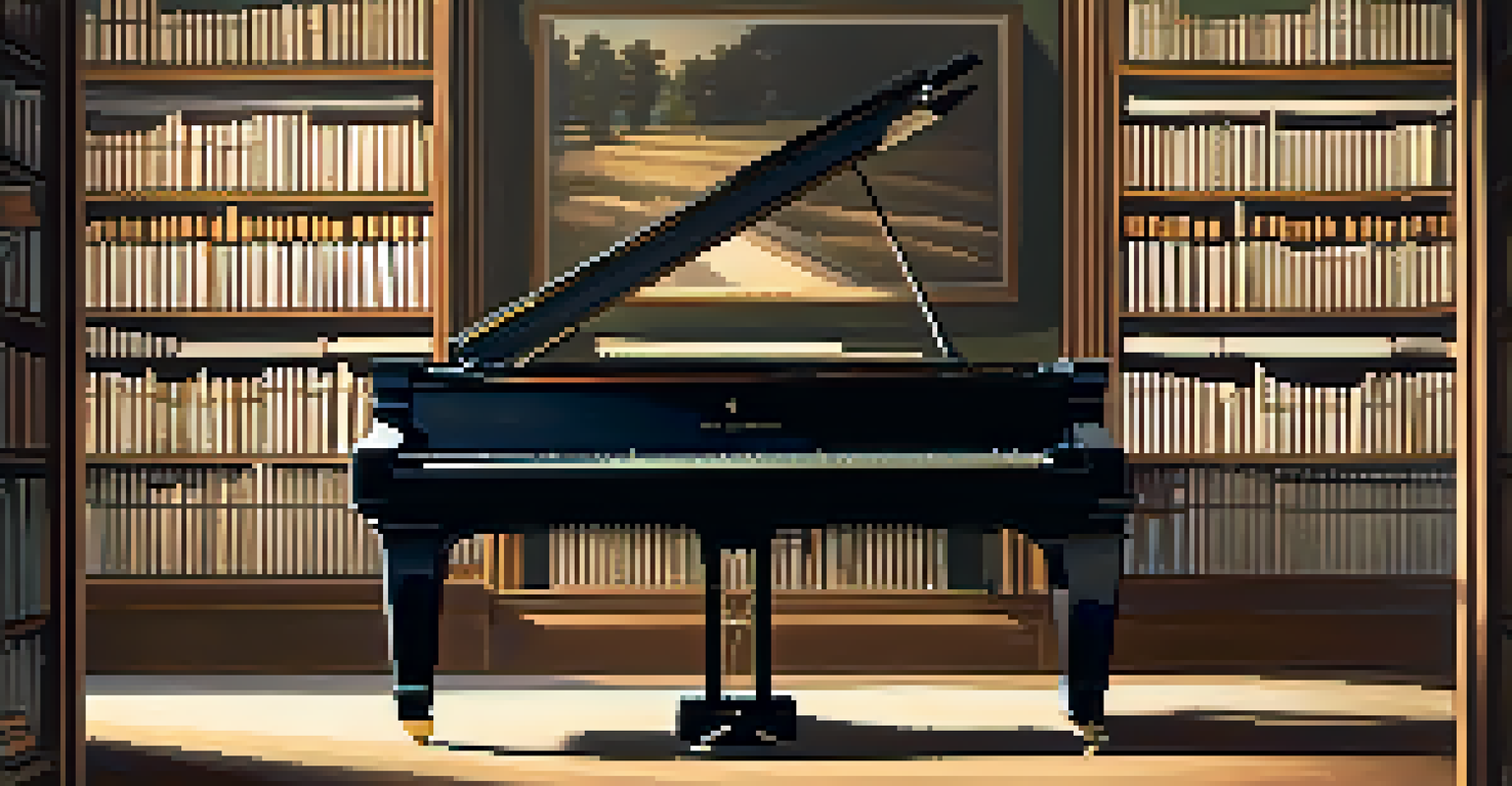The Role of Silence in Music: Analyzing Its Structural Impact

Understanding Silence: The Foundation of Musical Rhythm
Silence is often overlooked in music, yet it plays a crucial role in shaping rhythm. In essence, silence serves as a pause, allowing the listener to absorb what they just heard. Just as a painter uses negative space to highlight their subject, musicians use silence to create contrast and tension in their compositions.
Silence is the ultimate weapon of power.
Think of silence as the breath between words in a conversation. Without these pauses, communication can feel rushed and overwhelming. Similarly, in music, silence allows for a natural ebb and flow, giving melodies room to resonate and evoke emotions.
Moreover, silence can emphasize the notes that come before and after it. A well-placed rest can turn an ordinary phrase into something memorable, drawing attention to the beauty of sound that follows. This interplay of sound and silence is fundamental to how we experience music.
Silence as a Tool for Emotional Expression in Music
Silence is not just the absence of sound; it can be a powerful emotional tool. Composers often use silence to convey feelings of longing, sadness, or introspection. For instance, a dramatic pause can heighten anticipation before a climactic moment, making the eventual sound even more impactful.

Consider the use of silence in film scores. A quiet moment before a dramatic scene can amplify tension, making the audience hold their breath in expectation. This technique creates an emotional connection between the viewer and the narrative, showcasing how silence can enhance storytelling.
Silence Enhances Musical Emotion
Silence acts as a powerful emotional tool in music, amplifying feelings and creating anticipation during performances.
In genres like jazz, silence can be just as expressive as a solo. Musicians often leave spaces between notes, allowing the listener to reflect on what they’ve just experienced. This deliberate use of silence can evoke a sense of intimacy and vulnerability, deepening the emotional experience.
The Structural Role of Silence in Music Composition
From a structural perspective, silence provides a framework for musical ideas. It can serve as a boundary, creating sections within a piece and guiding the listener's journey. By incorporating silence, composers can establish clear transitions and shifts in mood, helping the audience navigate through complex compositions.
In music, silence is more important than sound.
Think of silence as a punctuation mark in a sentence. Just as a comma or period clarifies the meaning of words, silence delineates musical phrases and sections. This creates a sense of organization, allowing listeners to follow the composer’s intent without becoming lost in a sea of sound.
Additionally, silence can introduce variation and unpredictability into music. A sudden break in sound can catch the listener off guard, adding an element of surprise that keeps them engaged. This structural role of silence is essential for creating dynamic and compelling music.
Cultural Perspectives on Silence in Music
Different cultures interpret silence in music uniquely, adding layers of meaning to its use. In some Eastern traditions, silence is revered as a sacred space for reflection and meditation. This contrasts with Western music, where silence might be employed more for dramatic effect or to create tension.
For example, in traditional Japanese music, the concept of 'ma'—or the space between notes—is fundamental. This philosophy highlights how silence can convey depth and beauty, creating a rich listening experience. Such cultural insights remind us that silence is not a universal concept but rather one that varies in significance across different musical landscapes.
Silence Shapes Music Structure
In music composition, silence provides essential boundaries and transitions, guiding listeners through the musical narrative.
Understanding these cultural perspectives enriches our appreciation of silence in music. It encourages us to listen more closely and consider how silence interacts with sound in diverse contexts, ultimately broadening our musical horizons.
The Influence of Silence on Musical Genres
Silence plays a distinct role across various musical genres, influencing how music is composed and experienced. In classical music, for instance, composers often use silence to create dramatic tension, while in rock music, it might serve as a moment of reflection or build-up before a powerful chorus.
In electronic music, silence can be used strategically to create drops or build anticipation, enhancing the overall listening experience. These genre-specific uses of silence demonstrate how versatile and impactful this element can be, shaping the unique characteristics of each style.
Moreover, silence can also influence audience reception. A quiet moment in a loud concert can draw the audience's attention, creating a shared experience that heightens connection. This interplay between silence and sound is a vital aspect of how we engage with different musical genres.
The Connection Between Silence and Musical Improvisation
Improvisation in music heavily relies on the use of silence to create spontaneity and expression. Musicians often pause to reflect on their playing, allowing silence to breathe between notes and ideas. This moment of silence can lead to unexpected musical discoveries, fostering creativity and innovation.
In jazz, for instance, improvisers use silence as a canvas for their expression. A well-timed pause can allow the performer to contemplate their next move, creating a dialogue not just with the audience, but also with fellow musicians. This collaborative use of silence enriches the overall experience of the performance.
Cultural Views on Silence in Music
Different cultures interpret silence uniquely, adding rich layers of meaning that broaden our understanding of music.
This connection between silence and improvisation highlights the dynamic nature of music. It shows that silence is not merely an absence; rather, it is an active participant in the creative process, encouraging musicians to explore and experiment.
The Future of Silence in Modern Music
As music continues to evolve, the role of silence is also changing. In an age dominated by technology and digital production, silence can be manipulated in new ways, offering fresh perspectives on its use. Artists are increasingly using silence to challenge conventional norms and create immersive soundscapes.
For example, experimental musicians may incorporate extended periods of silence to provoke thought and engagement. This exploration of silence invites listeners to reconsider their relationship with sound, emphasizing active listening and mindfulness in music appreciation.

Moreover, as genres blend and cross-pollinate, the creative possibilities for silence expand. The future of music promises to be an exciting arena where silence continues to play a pivotal role, encouraging both artists and listeners to explore its transformative power.